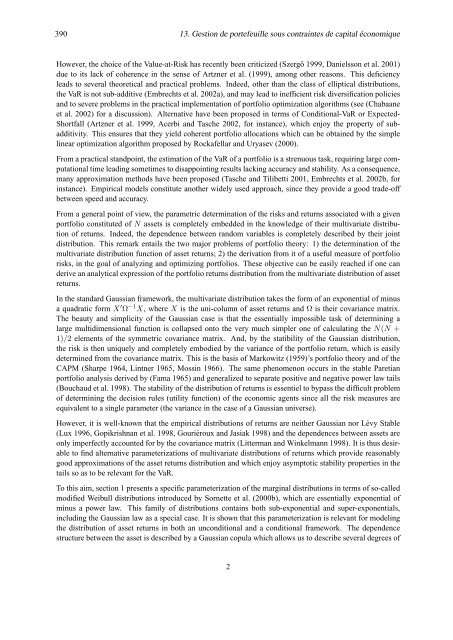statistique, théorie et gestion de portefeuille - Docs at ISFA
statistique, théorie et gestion de portefeuille - Docs at ISFA
statistique, théorie et gestion de portefeuille - Docs at ISFA
Create successful ePaper yourself
Turn your PDF publications into a flip-book with our unique Google optimized e-Paper software.
390 13. Gestion <strong>de</strong> <strong>portefeuille</strong> sous contraintes <strong>de</strong> capital économique<br />
However, the choice of the Value-<strong>at</strong>-Risk has recently been criticized (Szergö 1999, Danielsson <strong>et</strong> al. 2001)<br />
due to its lack of coherence in the sense of Artzner <strong>et</strong> al. (1999), among other reasons. This <strong>de</strong>ficiency<br />
leads to several theor<strong>et</strong>ical and practical problems. In<strong>de</strong>ed, other than the class of elliptical distributions,<br />
the VaR is not sub-additive (Embrechts <strong>et</strong> al. 2002a), and may lead to inefficient risk diversific<strong>at</strong>ion policies<br />
and to severe problems in the practical implement<strong>at</strong>ion of portfolio optimiz<strong>at</strong>ion algorithms (see (Chabaane<br />
<strong>et</strong> al. 2002) for a discussion). Altern<strong>at</strong>ive have been proposed in terms of Conditional-VaR or Expected-<br />
Shortfall (Artzner <strong>et</strong> al. 1999, Acerbi and Tasche 2002, for instance), which enjoy the property of subadditivity.<br />
This ensures th<strong>at</strong> they yield coherent portfolio alloc<strong>at</strong>ions which can be obtained by the simple<br />
linear optimiz<strong>at</strong>ion algorithm proposed by Rockafellar and Uryasev (2000).<br />
From a practical standpoint, the estim<strong>at</strong>ion of the VaR of a portfolio is a strenuous task, requiring large comput<strong>at</strong>ional<br />
time leading som<strong>et</strong>imes to disappointing results lacking accuracy and stability. As a consequence,<br />
many approxim<strong>at</strong>ion m<strong>et</strong>hods have been proposed (Tasche and Tilib<strong>et</strong>ti 2001, Embrechts <strong>et</strong> al. 2002b, for<br />
instance). Empirical mo<strong>de</strong>ls constitute another wi<strong>de</strong>ly used approach, since they provi<strong>de</strong> a good tra<strong>de</strong>-off<br />
b<strong>et</strong>ween speed and accuracy.<br />
From a general point of view, the param<strong>et</strong>ric d<strong>et</strong>ermin<strong>at</strong>ion of the risks and r<strong>et</strong>urns associ<strong>at</strong>ed with a given<br />
portfolio constituted of N ass<strong>et</strong>s is compl<strong>et</strong>ely embed<strong>de</strong>d in the knowledge of their multivari<strong>at</strong>e distribution<br />
of r<strong>et</strong>urns. In<strong>de</strong>ed, the <strong>de</strong>pen<strong>de</strong>nce b<strong>et</strong>ween random variables is compl<strong>et</strong>ely <strong>de</strong>scribed by their joint<br />
distribution. This remark entails the two major problems of portfolio theory: 1) the d<strong>et</strong>ermin<strong>at</strong>ion of the<br />
multivari<strong>at</strong>e distribution function of ass<strong>et</strong> r<strong>et</strong>urns; 2) the <strong>de</strong>riv<strong>at</strong>ion from it of a useful measure of portfolio<br />
risks, in the goal of analyzing and optimizing portfolios. These objective can be easily reached if one can<br />
<strong>de</strong>rive an analytical expression of the portfolio r<strong>et</strong>urns distribution from the multivari<strong>at</strong>e distribution of ass<strong>et</strong><br />
r<strong>et</strong>urns.<br />
In the standard Gaussian framework, the multivari<strong>at</strong>e distribution takes the form of an exponential of minus<br />
a quadr<strong>at</strong>ic form X ′ Ω −1 X, where X is the uni-column of ass<strong>et</strong> r<strong>et</strong>urns and Ω is their covariance m<strong>at</strong>rix.<br />
The beauty and simplicity of the Gaussian case is th<strong>at</strong> the essentially impossible task of d<strong>et</strong>ermining a<br />
large multidimensional function is collapsed onto the very much simpler one of calcul<strong>at</strong>ing the N(N +<br />
1)/2 elements of the symm<strong>et</strong>ric covariance m<strong>at</strong>rix. And, by the st<strong>at</strong>ibility of the Gaussian distribution,<br />
the risk is then uniquely and compl<strong>et</strong>ely embodied by the variance of the portfolio r<strong>et</strong>urn, which is easily<br />
d<strong>et</strong>ermined from the covariance m<strong>at</strong>rix. This is the basis of Markowitz (1959)’s portfolio theory and of the<br />
CAPM (Sharpe 1964, Lintner 1965, Mossin 1966). The same phenomenon occurs in the stable Par<strong>et</strong>ian<br />
portfolio analysis <strong>de</strong>rived by (Fama 1965) and generalized to separ<strong>at</strong>e positive and neg<strong>at</strong>ive power law tails<br />
(Bouchaud <strong>et</strong> al. 1998). The stability of the distribution of r<strong>et</strong>urns is essentiel to bypass the difficult problem<br />
of d<strong>et</strong>ermining the <strong>de</strong>cision rules (utility function) of the economic agents since all the risk measures are<br />
equivalent to a single param<strong>et</strong>er (the variance in the case of a Gaussian universe).<br />
However, it is well-known th<strong>at</strong> the empirical distributions of r<strong>et</strong>urns are neither Gaussian nor Lévy Stable<br />
(Lux 1996, Gopikrishnan <strong>et</strong> al. 1998, Gouriéroux and Jasiak 1998) and the <strong>de</strong>pen<strong>de</strong>nces b<strong>et</strong>ween ass<strong>et</strong>s are<br />
only imperfectly accounted for by the covariance m<strong>at</strong>rix (Litterman and Winkelmann 1998). It is thus <strong>de</strong>sirable<br />
to find altern<strong>at</strong>ive param<strong>et</strong>eriz<strong>at</strong>ions of multivari<strong>at</strong>e distributions of r<strong>et</strong>urns which provi<strong>de</strong> reasonably<br />
good approxim<strong>at</strong>ions of the ass<strong>et</strong> r<strong>et</strong>urns distribution and which enjoy asymptotic stability properties in the<br />
tails so as to be relevant for the VaR.<br />
To this aim, section 1 presents a specific param<strong>et</strong>eriz<strong>at</strong>ion of the marginal distributions in terms of so-called<br />
modified Weibull distributions introduced by Sorn<strong>et</strong>te <strong>et</strong> al. (2000b), which are essentially exponential of<br />
minus a power law. This family of distributions contains both sub-exponential and super-exponentials,<br />
including the Gaussian law as a special case. It is shown th<strong>at</strong> this param<strong>et</strong>eriz<strong>at</strong>ion is relevant for mo<strong>de</strong>ling<br />
the distribution of ass<strong>et</strong> r<strong>et</strong>urns in both an unconditional and a conditional framework. The <strong>de</strong>pen<strong>de</strong>nce<br />
structure b<strong>et</strong>ween the ass<strong>et</strong> is <strong>de</strong>scribed by a Gaussian copula which allows us to <strong>de</strong>scribe several <strong>de</strong>grees of<br />
2




